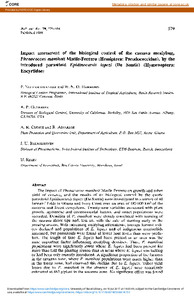| dc.contributor.author | Neuenschwander, P. |
| dc.contributor.author | Hammond, W.N.O. |
| dc.contributor.author | Gutierrez, A.P. |
| dc.contributor.author | Cudjoe, A.R. |
| dc.contributor.author | Adjakloe, R. |
| dc.contributor.author | Baumgärtner, J.U. |
| dc.contributor.author | Regev, U. |
| dc.date.accessioned | 2022-07-19T09:58:33Z |
| dc.date.available | 2022-07-19T09:58:33Z |
| dc.date.issued | 1989 |
| dc.identifier.citation | Neuenschwander, P., Hammond, W.N.O., Gutierrez, A.P., Cudjoe, A.R., Adjakloe, R., Baumgärtner, J.U. & Regev, U. (1989). Impact assessment of the biological control of the cassava mealybug, Phenacoccus manihoti Matile-Ferrero (Hemiptera: Pseudococcidae), by the introduced parasitoid Epidinocarsis lopezi (De Santis)(Hymenoptera: Encyrtidae). Bulletin of Entomological Research, 79(4), 579-594. |
| dc.identifier.issn | 0007-4853 |
| dc.identifier.uri | https://hdl.handle.net/20.500.12478/7553 |
| dc.description.abstract | The impact of Phenacoccus manihoti Matile-Ferrero on growth and tuber yield of cassava, and the results of its biological control by the exotic parasitoid Epidinocarsis lopezi (De Santis) were investigated in a survey of 60 farmers' fields in Ghana and Ivory Coast over an area of 180 000 km2 of the savana and forest ecosystems. Twenty-nine variables associated with plant growth, agronomic and environmental factors, and insect populations were recorded. Densities of P. manihoti were closely correlated with stunting of the cassava shoot tips and, less so, with the rate of stunting early in the growing season. With increasing mealybug infestations, average harvest indices declined and populations of E. lopezi and of indigenous coccinellids increased, but parasitoids were found at lower host levels than were predators. The length of time E. lopezi had been present in an area was the most important factor influencing mealybug densities. Thus, P. manihoti populations were significantly lower where E. lopezi had been present for more than half the planting season than in areas where E. lopezi was lacking or had been only recently introduced. A significant proportion of the farmers in the savanna zone, where P. manihoti populations were much higher than in the forest zone, had observed this decline due to E. lopezi. Tuber yield losses due to P. manihoti in the absence of E. lopezi were tentatively estimated at 463 g/plant in the savanna zone. No significant effect was found in the forest region. When E. lopezi was present, average P. manihoti damage scores were reduced significantly, both in the savanna and forest regions. The increase in yields was 228g/plant or about 2.48 t/ha in the savanna region |
| dc.format.extent | 579-594 |
| dc.language.iso | en |
| dc.subject | Cassava |
| dc.subject | Phenacoccus Manihoti |
| dc.subject | Epidinocarsis Lopezi |
| dc.subject | Parasitoids |
| dc.subject | Disease Control |
| dc.subject | West Africa |
| dc.subject | Impact Assessment |
| dc.subject | Pseudococcidae |
| dc.title | Impact assessment of the biological control of the cassava mealybug, Phenacoccus manihoti Matile-Ferrero (Hemiptera: Pseudococcidae), by the introduced parasitoid Epidinocarsis lopezi (De Santis)(Hymenoptera: Encyrtidae) |
| dc.type | Journal Article |
| cg.contributor.crp | Roots, Tubers and Bananas |
| cg.contributor.affiliation | International Institute of Tropical Agriculture |
| cg.contributor.affiliation | University of California |
| cg.contributor.affiliation | Plant Protection and Quarantine Unit Department of Agriculture, Ghana |
| cg.contributor.affiliation | Swiss Federal Institute of Technology |
| cg.contributor.affiliation | Ben Gurion University |
| cg.coverage.region | Africa |
| cg.coverage.region | West Africa |
| cg.coverage.country | Cote d’Ivoire (Ivory Coast) |
| cg.coverage.country | Ghana |
| cg.coverage.hub | Headquarters and Western Africa Hub |
| cg.researchtheme | Plant Production and Health |
| cg.identifier.bibtexciteid | NEUENSCHWANDER:1989 |
| cg.isijournal | ISI Journal |
| cg.authorship.types | CGIAR and developing country institute |
| cg.iitasubject | Agronomy |
| cg.iitasubject | Cassava |
| cg.iitasubject | Disease Control |
| cg.iitasubject | Impact Assessment |
| cg.iitasubject | Pests of Plants |
| cg.iitasubject | Plant Breeding |
| cg.iitasubject | Plant Diseases |
| cg.iitasubject | Plant Health |
| cg.iitasubject | Plant Production |
| cg.journal | Bulletin of Entomological Research |
| cg.accessibilitystatus | Limited Access |
| cg.reviewstatus | Peer Review |
| cg.usagerightslicense | Copyrighted; all rights reserved |
| cg.targetaudience | Scientists |
| cg.identifier.doi | https://dx.doi.org/10.1017/S0007485300018733 |
| cg.iitaauthor.identifier | Peter NEUENSCHWANDER: 0000-0003-0580-0376 |
| cg.futureupdate.required | No |

